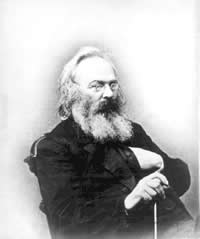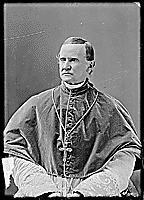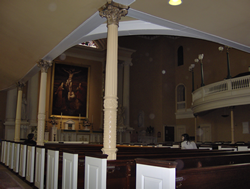Spotlight Archive
Two hundred years ago, April 8, the Catholic Church in the United States passed from infancy to childhood. Four major dioceses encompassing every significant center of Catholic population were erected. The American Church had established itself in the New Republic.
Baltimore is the primatial see of the United States, founded with the country's birth and including the entire nation within its jurisdiction for the first three decades of its existence. The creation of four new dioceses, occurring simultaneously in 1808, marked the beginning of a new era of organization and expansion for the Church. [Clarification, posted January 2011: In the meantime, the Diocese of Louisiana and the Two Floridas had also become part of the United States through the Louisiana Purchase.]
 In New England, the Diocese of Boston signified the importance of that city to the formation of the United States. The earliest urban settlement in the colonies, Boston remained a bastion of Calvinism and an unfriendly environment for Catholics through the Revolutionary period. Its selection as one of the first dioceses reflected the growing Catholic community that gathered there under the religious freedom ushered in by the Revolution. The Massachusetts constitution of 1780 finally permitted Catholics to practice their faith, and in 1788 Abbé de la Poterie became Boston’s first resident priest. The Church of the Holy Cross was built in 1800 and it later became the city's first cathedral.
In New England, the Diocese of Boston signified the importance of that city to the formation of the United States. The earliest urban settlement in the colonies, Boston remained a bastion of Calvinism and an unfriendly environment for Catholics through the Revolutionary period. Its selection as one of the first dioceses reflected the growing Catholic community that gathered there under the religious freedom ushered in by the Revolution. The Massachusetts constitution of 1780 finally permitted Catholics to practice their faith, and in 1788 Abbé de la Poterie became Boston’s first resident priest. The Church of the Holy Cross was built in 1800 and it later became the city's first cathedral.
Bishop Jean Cheverus was the diocese's first head. Some of the American Church’s most significant nineteenth-century converts lived in Boston and its environs, including Daniel Barber, Mary Tincker, Orestes Brownson, and Isaac Hecker. Eventually, the small native Catholic population would be overwhelmed by an immigrant group that would dominate Boston’s social, political, and ecclesial life, the Irish Catholics. By 1866, there were 300,000 Catholics in the diocese, which was made an archbishopric in 1875. Initially covering the whole of New England, the diocese lost territory in 1843 (Hartford), in the 1850s (Burlington and Portland), in the 1870s (Springfield and Providence) and finally in 1904 (Fall River).
South along the East Coast lay New York, quickly overtaking its competitors as the preeminient seat of commerce and culture in the New Republic. As in Massachusetts, Catholicism was proscribed in colonial New York until after the Revolution. Fr. Ferdinand Farmer visited the city secretly in the late 1770s, when it boasted some 200 Catholics. Home to important early parishes such as St. Peter’s (1785), the city’s Catholic community by 1808 was already swelling with immigrants from Europe. After 1815, as workers began arriving to build the canals and railroads crisscrossing the state, it became the door through which millions of Catholic migrants from Europe and Latin America would enter the country. Significant figures in the early days of the diocese included Elizabeth Ann Seton and Pierre Toussaint.
 New York’s first bishop, Richard Concanen, consecrated in Rome, never made it to the United States. Bishop John Connolly took up residence in 1815. The most famous bishop of the nineteenth century was John Hughes, who became the see’s first archbishop in 1850. During the middle decades of the century the original territory was divided into new dioceses at Buffalo, Albany, Newark, and Brooklyn. By 1864, the archdiocese was one-tenth its original size yet had multiplied its population to 400,000 Catholics. It was an archbishop of New York, John McCloskey, who became the nation’s first cardinal in 1875. In 1895, Frances Cabrini founded Columbus Hospital, one significant piece of a rapid expansion of the Church's social institutions. In 1896, St. Joseph’s Seminary in Dunwoodie replaced St. Joseph’s Provincial Seminary at Troy as the locus of the region's priest-training. The continuing ethnic character of the diocese was manifest in 1920 when 51 of 113 parishes in Manhattan were national. Until 1936, New York was the country’s most populous diocese.
New York’s first bishop, Richard Concanen, consecrated in Rome, never made it to the United States. Bishop John Connolly took up residence in 1815. The most famous bishop of the nineteenth century was John Hughes, who became the see’s first archbishop in 1850. During the middle decades of the century the original territory was divided into new dioceses at Buffalo, Albany, Newark, and Brooklyn. By 1864, the archdiocese was one-tenth its original size yet had multiplied its population to 400,000 Catholics. It was an archbishop of New York, John McCloskey, who became the nation’s first cardinal in 1875. In 1895, Frances Cabrini founded Columbus Hospital, one significant piece of a rapid expansion of the Church's social institutions. In 1896, St. Joseph’s Seminary in Dunwoodie replaced St. Joseph’s Provincial Seminary at Troy as the locus of the region's priest-training. The continuing ethnic character of the diocese was manifest in 1920 when 51 of 113 parishes in Manhattan were national. Until 1936, New York was the country’s most populous diocese.
 Yet further south was the nation’s first capital and the heart of Revolutionary America, Philadelphia. Benefiting from the tolerant regime set in place by William Penn’s Quakers, Philadelphia had throughout the colonial period been a haven for Catholic settlers. Some of the nation’s earliest parishes were located there: St. Joseph’s (1733) was the colonies’ first Catholic place of worship since the destruction of the chapel at Old St. Mary’s in 1704. The region contributed prominent Catholics to the American founding, including Commodore John Barry and Constitution-signer Thomas FitzSimmons. In 1808 there were 10,000 Catholics in Philadelphia and many more scattered throughout Pennsylvania.
Yet further south was the nation’s first capital and the heart of Revolutionary America, Philadelphia. Benefiting from the tolerant regime set in place by William Penn’s Quakers, Philadelphia had throughout the colonial period been a haven for Catholic settlers. Some of the nation’s earliest parishes were located there: St. Joseph’s (1733) was the colonies’ first Catholic place of worship since the destruction of the chapel at Old St. Mary’s in 1704. The region contributed prominent Catholics to the American founding, including Commodore John Barry and Constitution-signer Thomas FitzSimmons. In 1808 there were 10,000 Catholics in Philadelphia and many more scattered throughout Pennsylvania.
Michael Egan was the first bishop; his jurisdiction included all of the states of Pennsylvania and Delaware as well as much of New Jersey. Its parishes' early years were troubled by the trustee controversy. With the other port dioceses, Philadelphia’s Catholic population would grow exponentially as a result of heavy immigration later in the century—its foreign-born Catholics included its fourth bishop, St. John Neumann. In 1823, St. Charles Borromeo Seminary opened, and the colleges of Villanova and St. Joseph opened in 1842 and 1851 respectively. The diocese of Pittsburgh took the western half of the initial territory in 1843; an 1868 division broke off Wilmington, Scranton, and Harrisburg; Allentown was created in 1961.
Signifying the aspirations of both nation and Church to expand westward, the fourth new diocese was Bardstown, Kentucky, located on the American frontier. Among those hardy Americans crossing the mountains into the west were a number of Catholics, many of whom settled in the southern Ohio valley. By 1795 there were about 300 Catholics, mostly of British descent, living in the Bardstown area.
Benedict Flaget became the “first bishop of the West” in 1808. In 1848, he invited French Trappists into his diocese to establish the the monastery of Gethsemani. Martin Spalding was born in Bardstown in 1810; he would be bishop there and later in Baltimore. In geographical size, Bardstown dwarfed the other dioceses: It stretched from the Great Lakes to the Deep South and from the Allegheny Mountains to the Mississippi River. Its territory would eventually comprise thirty American dioceses. Led by missionary priest Stephen Badin, Bardstown would serve as a base for extending the Church into the Old Northwest Territory and Mississippi Valley. The early settlement was eventually eclipsed by other Kentucky cities. A growing population of German and Irish immigrants made Louisville an important center of Catholicism, and the see was moved there in 1841.
All of these local churches remain important centers of Catholicism in the United States, but their historical roles should not be neglected. The entwinement of the Catholic past with the story of America is exemplified in the histories of the early dioceses.
©2008 CatholicHistory.net. Posted April 5, 2008.
Photos, from top: Orestes Brownson; Archbishop John Hughes, courtesy of National Archives and Records Administration (unrestricted); Old St. Joseph's Church, Philadelphia, © CatholicHistory.net.
Sources and Further Reading
Robert Johnson Lally, "Catholic Church in Massachusetts"; Thomas J. Shelley, "Catholic Church in New York,"; Joseph C. Linck, CO, "Catholic Church in Pennsylvania"; and Clyde F. Crews, "Catholic Church in Kentucky,"
